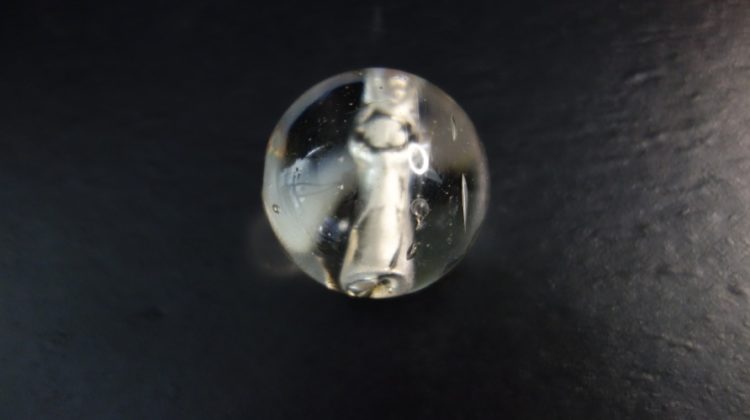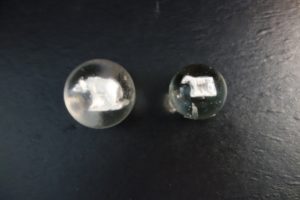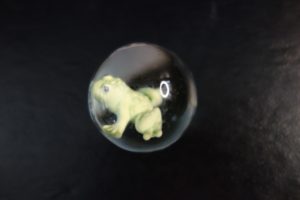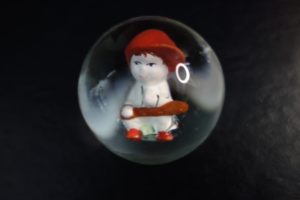
The proper order of things is often a mystery to me.”
– Cheshire Cat
A Few Words about Words
What precisely is the difference between an antique and a contemporary figural marble? Before 1890 marbles were handmade; today gorgeous glass marbles are still being made by hand. Are “contemporary” marbles those made using the most up to date techniques, such as lamp work, modern methods, glass and materials, and so on?
If so, then that’s that: it is neat, clean, and no one should ever confuse a contemporary handmade marble with an old one; an old sulfide or figural marble from a contemporary figural, for example.
Right. Except when it isn’t. Sometimes a contemporary figural cannot be differentiated from a Victorian except through complicated scanning electron microscope (SEM) tests!
Contemporary Figural Marbles: The Old Marble Nut
We were in West Virginia on another marble mission and were attending a glass show in Bridgeport in July 2015 when we literally stumbled into Scott Meyer’s studio on Main Street in Weston. His Studio is West Virginia American Art Glass LLC.
To our knowledge Scott does not and has not made contemporary figural marbles. However, what he does with glasmurmeln speaks volumes about being too quick to determine that a marble is either old or modern.
He is gifted and has worked decades to hone his glass art and craft.[1] Over the decades of marble collecting we have met an untold number of marble people: collectors, artists, and even a marble ghost once in Louisiana. But we have never met a more generous, upbeat, and deeply grounded individual as Scott.
He calls himself the “old marble nut” and that is the way he signs his work (OLD). We did not have Scott’s work in our collection. We spent some time with him in his studio that hot July afternoon and we learned that he has collected marbles since he was nine and that he has “four million” marbles!
Scott certainly makes extraordinary contemporary art glass. But he makes glass marbles in the 19th century German glashütte tradition. The most exciting thing to us is that Scott used authentic antique German tools to make a marble for us!
He had a friend who brought the tools from Germany for him. Now he has a collection of such old tools in his shop and he uses them often.
Like contemporary art marbles, contemporary figural marbles could be made with antique tools and methods. He used mica which he dug himself. We did not ask him to, but Scott demonstrated how he can make contemporary marbles in an antique manner. He worked the glass the same way it was worked in 19th century Lauscha Germany. It was thrilling to see his skill, imagination, and artisanship.
OK, it can be nearly impossible to tell some new from old glass marbles.
But What is a Figural or Sulphide Marble Anyway?
While patents for sulfide cameos were issued in the early 19th century in England and then in France, Victorian figural or sulphide glass marbles date from about 1884[2]. Sulfide marbles continued to be produced, mostly in the German cottage and small glashausindustrie, until at least the 1920s. We hesitate to suggest that they were made in any quantity after World War I.

While there are sources which claim that sulfide marbles contain sulphur, this is not the case. The figures, numbers, and so on inside the marbles are made of kaolin (clay), which is white, and the brightness is caused by tiny bubbles which collect around the figure.
Some sulfides have more free-ranging bubbles in the glass than others. You can see a few of these air bubbles in the figure to the right in the photograph. To gain a bit more understanding of why there are bubbles in the glass and the methods of getting the figure inside check “Sulphide Marbles” by Mark Chervenka.[3]
Each antique sulphide marble was handmade as were the molds for the kaolin figures inside the glass. So, the placement of each figure is unique to the marble. Check the Angel in the sulfide at the start of this post. Of course no two can ever be exactly alike.
Since the clay artifact was inserted into molten glass and since there was almost certainly a differential in the temperature of the glass and the clay it is inevitable that some figures were broken in production. Also, some workers were more skilled than others.
Antique sulphides contain animals, children, adults, elephants, flowers, numbers, a watch, a baby in a basket, a spotted dog, and so on. Robert Grist in Antique & Collectible Marbles reports that he has heard of but not seen a train, ship with full mast and a stagecoach with four horses.[4]
No one knows how many different Victorian sulfides are out there. Incidentally, Jim Davis, glass artist extraordinaire in Pennsboro, WV, did make a contemporary train sulfide which stretches across four marbles locomotive to caboose!

What About Contemporary Figural Marbles?
Well, here’s one! The “halo” is our light source and not something in the glass!
In the summer of 2018 we spoke by telephone with Sam Hogue in Ellenboro, WV. He is a glass artist and owner of Sam’s Crystal Creations. He makes both handmade and machine made marbles and we have visited his home and shop several times. While looking online we discovered that he made contemporary art figural marbles. We are unsure exactly when he made them or if he still does but we have the impression that he does not make them any longer.
On the ‘phone he said that early on with sulfides he experimented with marble artist Eddie Seese. We have Seese’s work in our collection too.
The froggy-toad marble is 1½” in crystal glass which magnifies the handsome (warty) green frog (toad?). There is no pontil mark. It is signed ‘Sam Hogue 2018’.

Joseph St. Clair & the House of Glass
We visited the St. Clair House of Glass in Elwood, Indiana in 2011 but we saw no sulfide marbles nor paperweights at that time. However, in 2016 in Arcadia, FL, we did find a 2” contemporary figural marble made and hand painted, as you can see in the photograph, by Joseph St. Clair. St. Clair was born in 1909 and he died in 1985. Again, please excuse the halo.
We researched the St. Clair marble extensively in 2016. We called The House of Glass and we were told by staff that Joe St. Clair often put stickers on his work (many glass artists resist signing their art) and that the sticker may have been lost from our marble. Also, we were told the marble was probably made in the 1960s.
Like the Hogue marble and unlike historic sulfides, the St. Clair marble is crystal clear. Victorian sulfides did not use crystal glass.
Robert Block in Marbles Identification and Price Guide Revised and Expanded 4th Edition shows the same little boy painted yellow and facing the opposite direction. The hand-painted details on the hat and shoes in our marble are red rather than yellow. There is a touch of light green grass, a brown bat, and like in the Block photograph the sulfide is detailed with black: eyes, shirt, etc. There is a tiny red mouth. The marble has one bubble.
Other contemporary glass artists have made sulfide marbles. These include Charles Gibson, Harry and Kathleen Boyer, and a few others.
Contemporary Figural Marbles: Apples & Oranges
Experienced collectors rarely mistake a Victorian sulfide for a contemporary figural marble. There is generally, if nothing else, a price differential between the two. But we know for a fact that collectors do sometimes get befuddled.
But let’s muddle the water even more. Between December 1993 and February 1994 sulfides, which appeared to be genuine Victorian, began to surface. “The problem is that before the new groups entered the market there were less than one dozen original doubles previously known. Are the recently offered doubles and singles genuine Victorian-era originals (Chervenka)?” Remember, regardless of how many “genuine” sulfides have existed at any given time, we really have no idea how many were made; how many were exported to the States and how many are still in circulation.
The back story for the new old sulfides is fascinating. We will not go into the stories, which reflect almost point for point the arguments we made in Chapter 2, “Atlanta Marbles: Fake, Fantasy, or Legend?” in The Secret Life of Marbles. We would love to explore the stories more, but we cannot imagine anyone doing a better job than Chervenka who also reports on the SEM tests conducted on the 1993-1994 marbles.
We Forgot to Warn You: There is a Final Exam!
So did you learn anything new? Did we challenge you to study a bit more? Your final exam is one question in two parts. Is the first photograph in this post a genuine Victorian sulfide or is it a contemporary figural marble? Why did you answer like you did?
Why, sometimes I’ve believed as many as six impossible things before breakfast.”
Alice in Alice in Wonderland
- Check Scott’s Biography at https://tamarackfoundation.org/directorylisting/scott-meyer/ (2/23/2022) You can also see gorgeous examples of his work at this Tamarack site. ↑
- We base the 1884 date on a product sheet provided to us by Dr. Gerhard Greiner-Bär who is a volunteer at the Heimat-und Geschichtsverein. Dr. Greiner-Bär published a brochure about Lauscha glass marbles, LauschaerGlasmärbel und die Welt der Murmeiln, in 2019. The product sheet is from Seppenhütte (1884), Elias Greiner Vetters Sohn and it clearly shows sulfide marbles as well as the more traditional German handmade swirls. Information with the product sheet, among other things, notes that the glasshouse was expanding because of the demand for glass rods and tubes for the other three Lauschaer glass houses and “…the decisive factor for this economic success of the Seppen [is] the new glass marble products.” Translated from German and italics added. We feel confident that, while sulfide marbles may have been made in area cottages earlier, 1884 was when production in quantity took off. ↑
- Mark Chervenka . “Sulphide Marbles”. Real or Repro. https://www.realorrepro.com/article/Sulphide-Marbles 2/24/2022 ↑
- Reference Everett Grist, 3rd Ed. pages 45 – 67. See also Paul Baumann. Collecting Antique Marbles Identification and Price Guide, 4th Ed. Iola, WI: Krause publications, pages 96 -111. ↑
Want to read more about marbles?

